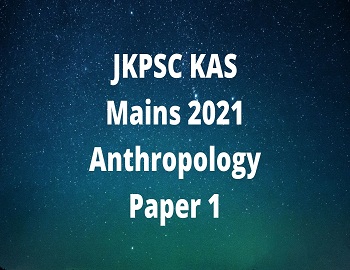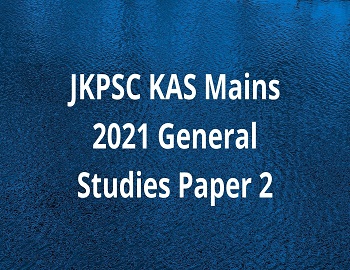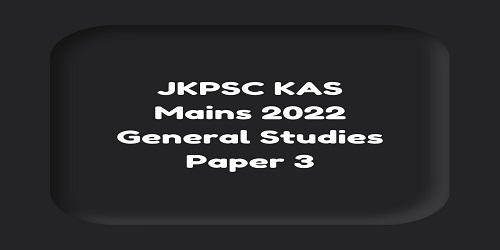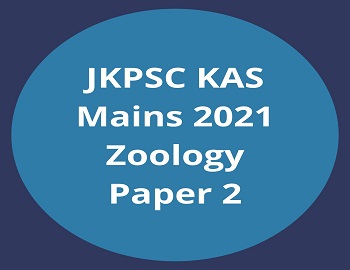JKPSC KAS Mains 2022 Psychology Paper 2:
INSTRUCTIONS
Please read each of the following instructions carefully before attempting the paper.
(i) There are eight questions divided in two Sections and printed in English. Candidate has to attempt Five questions in All. Questions No. 1 and 5 are compulsory and out of the remaining, any Three are to be attempted choosing at least One question from each Section. The number of marks carried by a Question/Part is indicated against it. Answers must be written in English in Question-Cum-Answer (QCA) Booklet in the space provided.
(ii) Your answer should be precise and coherent.
(iii) If you encounter any typographical error, please read it as it appears in the text book.
(iv) Candidates are in their own interest advised to go through the general instructions on the back side of the title page of the Answer Script for strict adherence.
(v) No continuation sheets shall be provided to any candidate under any circumstances.
(vi) No blank page be left in between answer to various questions.
SECTION- A
1. Answer the following questions in about 150 words each: (5 x 10 = 50)
(a) How can a principle of operant conditioning explain why some people check their cell phones so often?
(b) What role can mental imagery play in enhancing the performance of sportspersons?
(c) What do you understand by Management by Objectives?
(d) Examine the link between consumption and happiness.
(e) What is ‘relative deprivation’? How does it explain why women compare themselves mostly with other working women and not with working men?
2. (a) Describe interventions based on the behaviourist and cognitive perspective that a psychologist may use to change prejudices. (20)
(b) What are the different challenges to the leadership construct? Discuss this with special reference to self-leadership. (15)
(c) What are the defining characteristics of a social dilemma? Briefly explain the different types of social dilemmas. (15)
3. (a) Are there any benefits of diversity in educational institutions? Discuss in the light of available literature. (20)
(b) Many do not interpret climate change and its impacts as a threat and do not feel worried about it. Provide psychological explanations why this may be the case. (15)
(c) Discuss how the Big Five Personality Theory can explain the hoarding behaviour seen during the pandemic. (15)
4. (a) How can Self-Regulated Learning be used to Support Students with Learning Disabilities in Classrooms? (20)
(b) Imagine that your workplace asks you to develop a campaign to reduce the number of cigarette butts littering the ground. Identify two strategies that would be effective and two strategies that would be ineffective. (15)
(c) Discuss how the social distancing required by the pandemic thwarts crucial human needs for belongingness. (15)
SECTION- B
5. Answer the following questions in about 150 words each: (5 x 10 = 50)
(a) What is the meaning of the tragedy of the commons? How does it relate to the current ecological crisis?
(b) Discuss the effects of internet addiction among adolescents. Suggest some strategies to deal with this issue.
(c) What psychological principles can be used to enhance the effectiveness of poverty eradication programs in India?
(d) Design a training program for defence personnel operating in low-intensity conflict areas.
(e) Discuss the advantages of the role of small groups in social actions and community handling of social problems.
6. (a) Can engagement in environmentally-friendly behaviour increase well-Being? Discuss in light of research evidence. (20)
(b) Describe strategies for creating a classroom environment conducive to academic achievement and students personal well-being. (15)
(c) Give relevant examples to explain what you understand by the term criterion and predictor in reference to the selection of employees. (15)
7. (a) Discuss the theories in psychology that can apply to AIDS Prevention. (20)
(b) Social inequality is a crucial factor in environmental risk perception. Discuss this statement in light of relevant research evidence. (15)
(c) Countries around the world are dealing with different facets of population growth. Suggest strategies that can help navigate this social dilemma. (15)
8. (a) Discuss the role of spatial-physical dimensions of the residential environment in influencing psychological well-being and the overall quality of life of the elderly population. (20)
(b) Discuss the differences between Jungian Psychotherapy and Adlerian Psychotherapy. (15)
(c) Describe the clinical picture of Avoidant Personality Disorder. (15)









Comments (No)